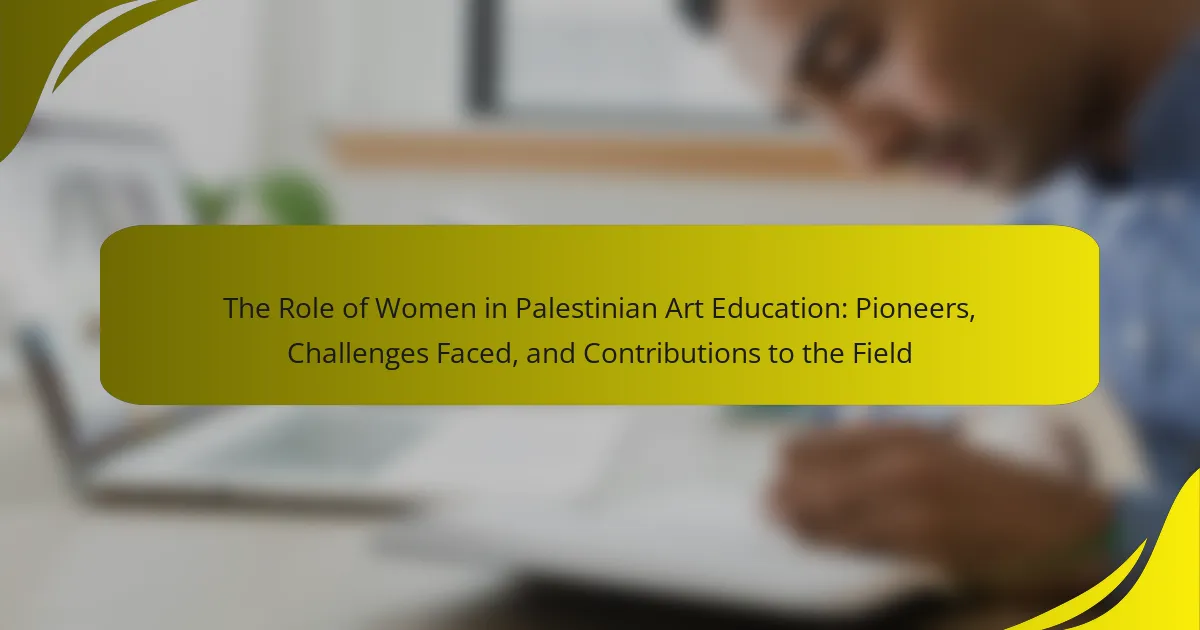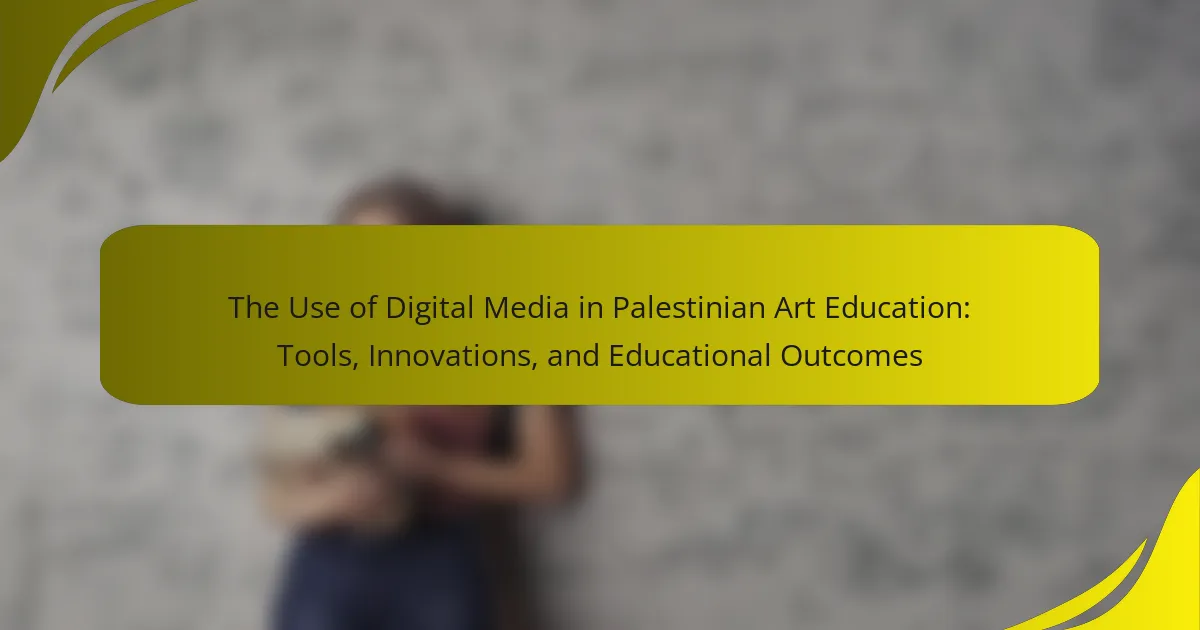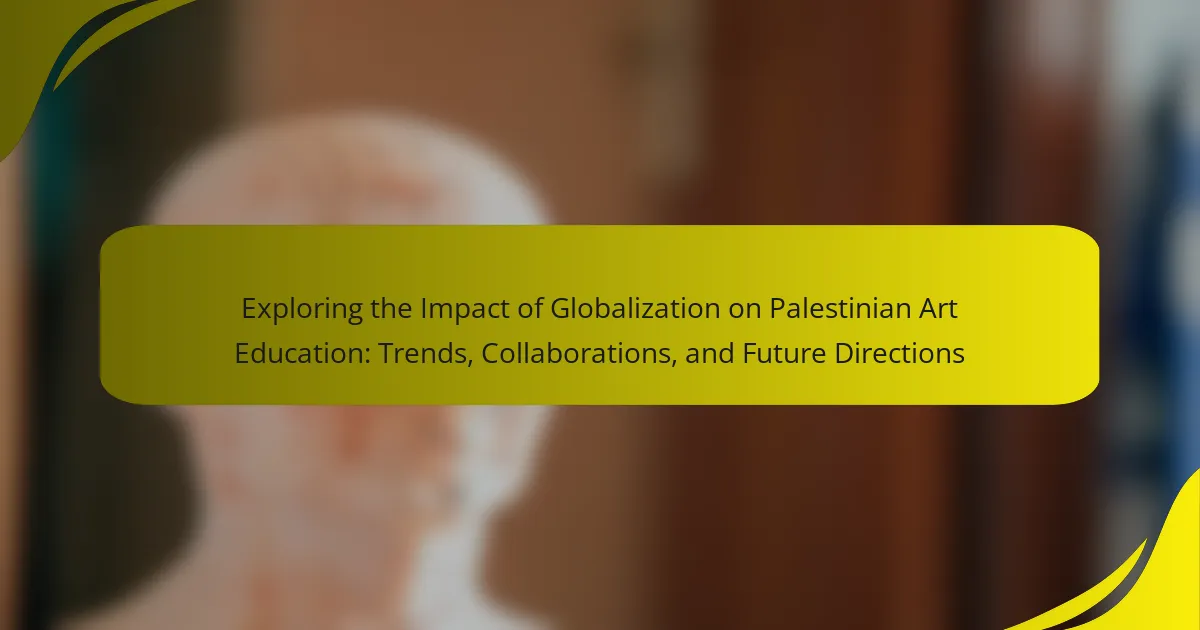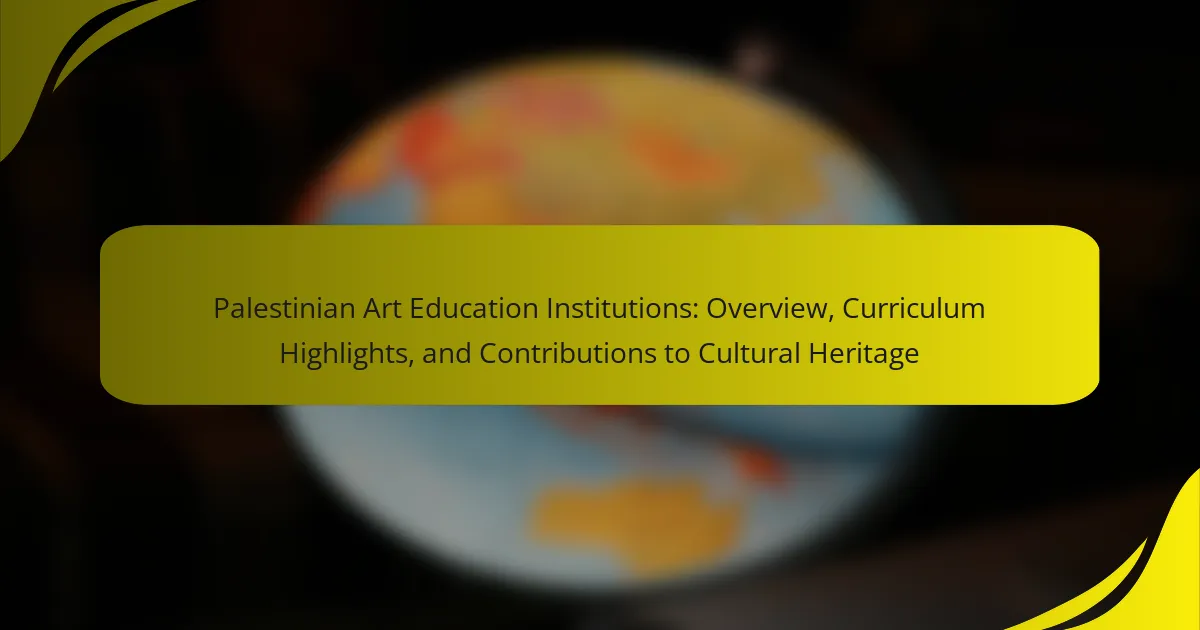Folklore plays a crucial role in Palestinian art education, acting as a cultural repository that preserves the identity and heritage of the Palestinian people. Through the exploration of traditional narratives, symbols, and artistic expressions, students develop a sense of belonging and continuity while enhancing their creativity and critical thinking skills. The article discusses various methods for integrating folklore into contemporary art education, including thematic exploration, storytelling techniques, and hands-on workshops focused on traditional crafts. It highlights the positive impact of folklore-based projects on student engagement and cultural awareness, as well as future initiatives aimed at further incorporating cultural narratives into curricula and utilizing digital platforms for broader outreach.
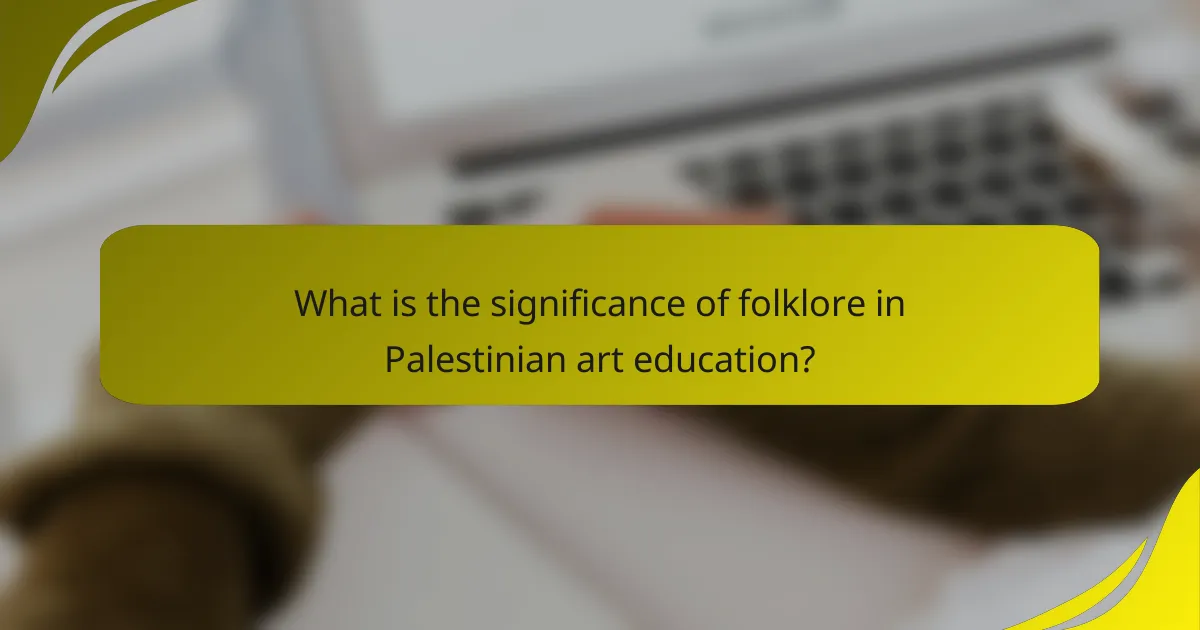
What is the significance of folklore in Palestinian art education?
Folklore is significant in Palestinian art education as it serves as a cultural repository. It preserves the identity and heritage of the Palestinian people. Through folklore, students learn traditional narratives, symbols, and artistic expressions. This education fosters a sense of belonging and continuity. It also encourages creativity by allowing students to reinterpret stories in modern contexts. Research indicates that integrating folklore enhances critical thinking and artistic skills. For instance, studies show that folklore-based projects improve engagement and cultural awareness among students. Overall, folklore enriches the educational experience by connecting art with cultural history.
How does folklore influence artistic expression in Palestinian culture?
Folklore significantly influences artistic expression in Palestinian culture by serving as a source of inspiration and identity. It encompasses traditional stories, myths, and legends that reflect the community’s history and values. Artists draw upon these narratives to create visual art, music, and dance. For example, the use of traditional motifs and symbols in paintings often narrates tales of resilience and heritage. Additionally, folklore informs storytelling techniques used in performances, enriching cultural representation. The integration of folklore in art reinforces communal bonds and preserves cultural memory. This connection to folklore is evident in various art forms, including embroidery and pottery, which often depict folkloric themes.
What themes are prevalent in Palestinian folklore?
Palestinian folklore prominently features themes of resistance, identity, and connection to land. Resistance is often depicted through stories of struggle against oppression. Identity is expressed through cultural practices, symbols, and traditional narratives. Connection to land is emphasized in tales that celebrate the beauty and significance of the Palestinian landscape. These themes reflect the historical and social context of Palestine. They resonate deeply with the experiences of the Palestinian people. Folklore serves as a vehicle for preserving cultural heritage and fostering community solidarity.
How do these themes manifest in various art forms?
Folklore themes manifest in various art forms through storytelling, visual arts, and performance. In storytelling, oral traditions convey cultural narratives and morals. Visual arts, such as painting and sculpture, depict folklore characters and scenes, illustrating cultural identity. Performance art, including dance and theater, brings folklore tales to life through movement and dialogue. Each art form serves as a medium for cultural expression and preservation. For example, traditional Palestinian embroidery often features motifs that reflect folklore stories. Additionally, folk music incorporates themes from oral traditions, reinforcing cultural heritage. These manifestations highlight the importance of folklore in shaping artistic expression within Palestinian culture.
Why is storytelling important in the context of Palestinian art education?
Storytelling is vital in Palestinian art education as it preserves cultural identity. It allows students to connect with their heritage through narratives. These stories reflect historical experiences and social realities of Palestinians. Art becomes a medium for expressing these narratives visually. Storytelling fosters creativity and critical thinking among students. It encourages personal interpretation and emotional engagement with art. This approach enhances understanding of cultural themes and values. Ultimately, storytelling enriches the educational experience by grounding art in lived experiences.
What are the traditional storytelling techniques used in Palestinian culture?
Traditional storytelling techniques in Palestinian culture include oral narratives, poetry, and performance. Oral narratives often involve storytelling sessions where tales are passed down through generations. These stories frequently incorporate historical events, cultural values, and moral lessons. Poetry is another vital technique, often used to express emotions and experiences related to identity and resistance. Performance storytelling, which includes dance and music, engages the audience and enhances the narrative experience. These techniques are essential for preserving cultural heritage and fostering community connections. They also serve educational purposes, teaching younger generations about their history and traditions.
How do these techniques enhance the learning experience in art education?
These techniques enhance the learning experience in art education by fostering creativity and critical thinking. They encourage students to engage with cultural narratives, deepening their understanding of artistic expression. Storytelling techniques, specifically, allow for personal connections to the material, making learning more relatable. This engagement leads to increased retention of information and skills. Research indicates that students involved in narrative-based learning demonstrate improved cognitive abilities. For instance, a study by Bruner (1986) highlights how storytelling enhances memory and comprehension. Thus, these techniques not only enrich artistic skills but also cultivate a deeper appreciation for cultural heritage.
What role do educators play in integrating folklore into art education?
Educators play a crucial role in integrating folklore into art education. They facilitate the connection between students and their cultural heritage. Educators introduce folklore themes that resonate with students’ identities. They design lesson plans that incorporate storytelling techniques from folklore. This approach enhances students’ understanding of their cultural narratives. Educators also encourage creative expression through various art forms. They provide resources that highlight local folklore and its significance. Research shows that this integration fosters cultural appreciation and critical thinking skills in students.
How can educators effectively teach folklore themes in the classroom?
Educators can effectively teach folklore themes in the classroom by integrating storytelling, visual arts, and cultural context. Storytelling engages students and helps them connect emotionally with the material. Visual arts allow students to express their understanding creatively. Incorporating cultural context provides depth and relevance to the themes being studied.
Research shows that active participation enhances learning. A study by the National Endowment for the Arts found that students involved in arts education demonstrate improved critical thinking skills. Additionally, using local folklore can make lessons more relatable. This approach fosters a sense of identity and belonging among students.
Incorporating discussions about the significance of folklore in cultural heritage also enriches the learning experience. This method promotes critical analysis and appreciation of diverse narratives. Overall, a multi-faceted approach using storytelling, art, and cultural discussions can effectively engage students in folklore themes.
What challenges do educators face in this integration?
Educators face several challenges in integrating folklore into Palestinian art education. One significant challenge is the lack of resources that effectively showcase folklore themes. Many educators struggle to find relevant materials that accurately represent cultural narratives. Additionally, there is often insufficient training for teachers on how to incorporate storytelling techniques into their curriculum. This gap in professional development can hinder effective teaching practices. Furthermore, educators may encounter resistance from students who are unfamiliar with or skeptical about folklore. This can lead to disengagement in the classroom. Another challenge is the need to balance traditional folklore with contemporary artistic practices. Educators must navigate how to blend these elements without losing cultural significance. Overall, these challenges impact the successful integration of folklore into art education in Palestine.
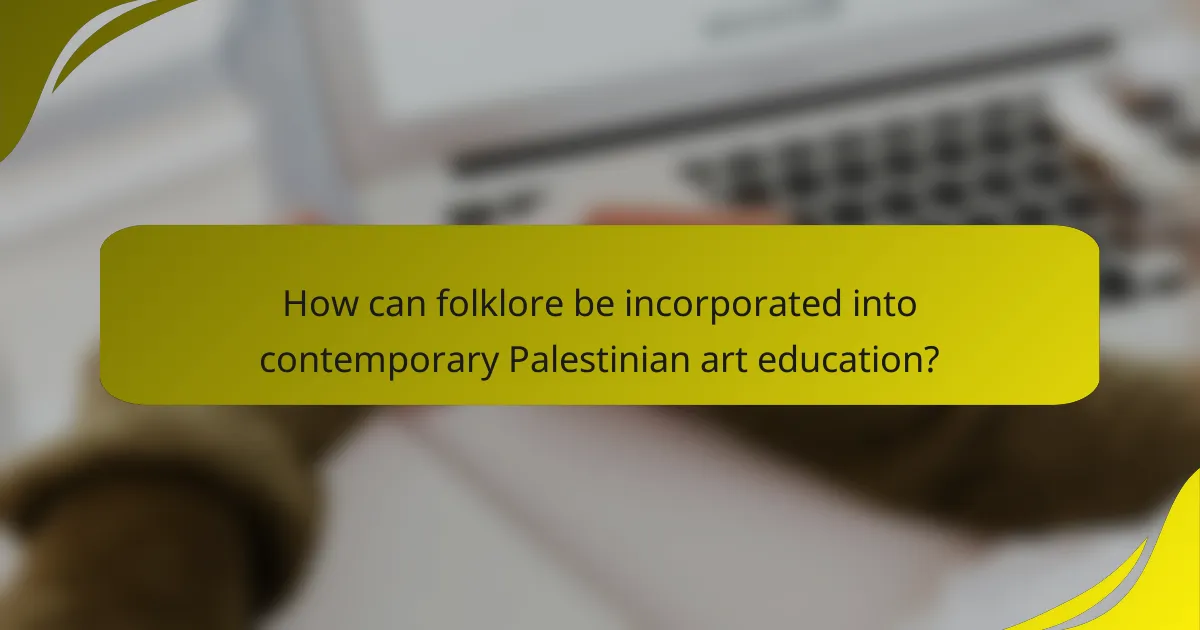
How can folklore be incorporated into contemporary Palestinian art education?
Folklore can be incorporated into contemporary Palestinian art education through thematic exploration and storytelling techniques. Educators can introduce traditional stories and motifs as sources of inspiration for artistic expression. This approach connects students to their cultural heritage and promotes identity.
Workshops can focus on traditional crafts, such as embroidery or pottery, integrating folklore into practical skills. Collaborative projects can involve community elders sharing stories, enhancing intergenerational dialogue.
Artistic interpretations of folklore can be showcased in exhibitions, providing a platform for students to present their work. This method fosters critical thinking and creativity.
Research indicates that integrating cultural narratives in education enhances engagement and retention. A study by Al-A’raj (2019) highlights the positive impact of folklore on student creativity in Palestinian art programs.
What methods can be used to blend traditional folklore with modern art practices?
Methods to blend traditional folklore with modern art practices include incorporating storytelling techniques into visual art. Artists can use motifs and symbols from folklore in contemporary mediums. Collaborations between traditional artisans and modern artists can create hybrid works. Workshops that teach folklore alongside modern techniques foster innovation. Digital platforms can showcase folklore-inspired modern art to a broader audience. Interactive installations can engage viewers with folklore narratives in contemporary contexts. These methods preserve cultural heritage while allowing for artistic evolution.
How does this blending affect students’ understanding of their cultural heritage?
Blending folkloric elements with contemporary art education enhances students’ understanding of their cultural heritage. This integration allows students to connect traditional narratives with modern artistic expressions. By engaging with folklore, students gain insights into their cultural identity and history. Research shows that such educational practices deepen cultural awareness. For instance, a study by Al-Azzeh et al. (2020) highlights the positive impact of folklore on cultural retention among Palestinian youth. This blending fosters a sense of belonging and pride in one’s heritage. Consequently, students develop a more nuanced appreciation of their cultural roots.
What are some successful examples of this integration in practice?
Successful examples of integrating folklore in Palestinian art education include community workshops and school programs. These initiatives often incorporate traditional storytelling techniques. For instance, the “Palestinian Folklore and Art” project has engaged students in creating art based on local legends. This approach promotes cultural heritage and artistic expression. Additionally, the “Art and Folklore” workshops in various schools have resulted in exhibitions showcasing student artwork inspired by folklore. These programs effectively enhance students’ understanding of their cultural identity. Research indicates that such integration improves students’ engagement and creativity in art education.
Why is it essential to preserve folklore within art education?
Preserving folklore within art education is essential for cultural identity and continuity. Folklore embodies the traditions, values, and narratives of a community. It serves as a bridge connecting generations and fostering a sense of belonging. In art education, integrating folklore enhances creativity and critical thinking. Students engage with their heritage through storytelling and artistic expression. This engagement promotes cultural awareness and respect for diversity. Research shows that incorporating local folklore in education can improve student engagement and retention of cultural knowledge. Therefore, preserving folklore enriches the educational experience and strengthens community ties.
How does folklore contribute to cultural identity among Palestinian youth?
Folklore contributes significantly to cultural identity among Palestinian youth by preserving traditions and narratives. It serves as a medium for expressing shared values, history, and experiences. Folklore includes stories, music, and dance that reflect the Palestinian struggle and resilience. These cultural elements foster a sense of belonging and community among youth. Engaging with folklore helps them understand their heritage and cultural roots. Research indicates that folklore can enhance self-identity and pride in cultural heritage. For instance, storytelling workshops have shown positive impacts on youth’s connection to their culture. This connection is crucial for maintaining cultural continuity in a rapidly changing world.
What impact does folklore preservation have on community engagement?
Folklore preservation significantly enhances community engagement. It fosters a sense of identity and belonging among community members. By sharing traditional stories and practices, individuals connect with their cultural heritage. This connection strengthens social bonds within the community. Additionally, folklore preservation encourages participation in cultural events and activities. Engaged communities often collaborate to celebrate their traditions. Research indicates that communities with active folklore practices report higher levels of social cohesion. Such engagement promotes intergenerational dialogue, allowing older and younger members to share experiences. Overall, folklore preservation serves as a vital tool for community unity and active participation.
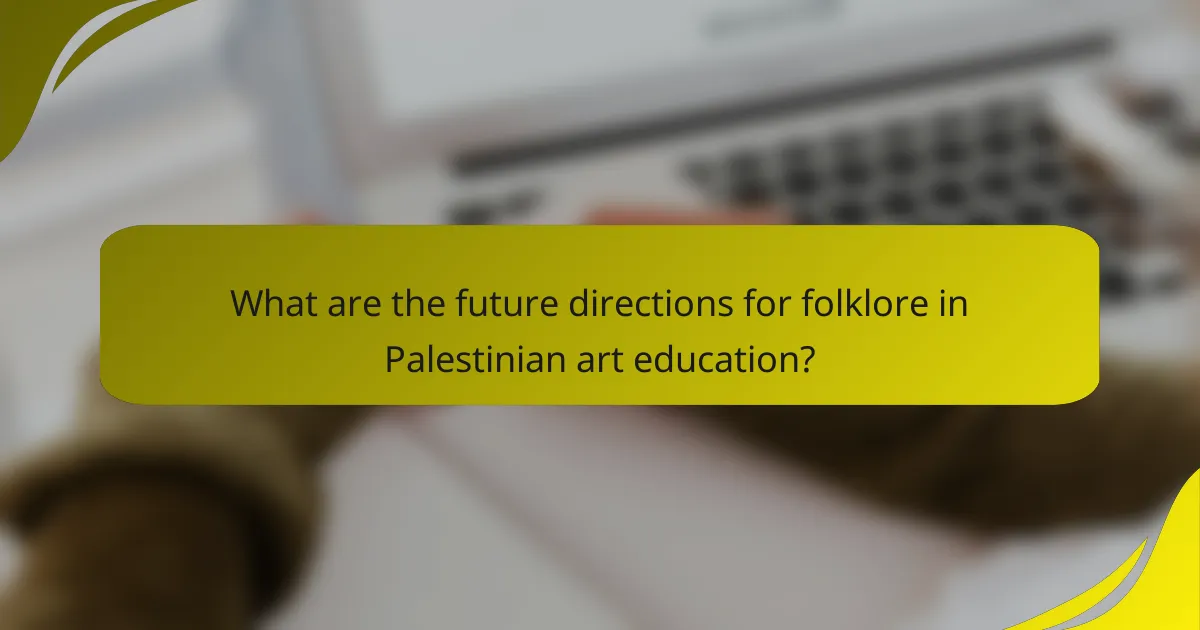
What are the future directions for folklore in Palestinian art education?
Future directions for folklore in Palestinian art education include integrating traditional narratives into curricula. This approach emphasizes the importance of cultural identity. Educators aim to enhance students’ understanding of their heritage. Collaborative projects with local artists can provide practical experience. Workshops focusing on storytelling techniques are also being developed. Digital platforms may be utilized to share folklore more widely. Research indicates that such methods can foster creativity and critical thinking. These initiatives reflect a growing recognition of folklore’s role in preserving cultural heritage.
How can technology enhance the teaching of folklore in art education?
Technology can enhance the teaching of folklore in art education by providing interactive and immersive learning experiences. Digital tools like virtual reality can recreate traditional settings, allowing students to engage with folklore in a dynamic way. Multimedia presentations can showcase visual storytelling techniques, enriching students’ understanding of cultural narratives. Online platforms enable collaboration, allowing students to share their interpretations of folklore with peers globally. Access to digital archives offers students a wealth of resources, including historical texts and artworks related to folklore. Additionally, social media can facilitate discussions and sharing of folklore-inspired art projects. These technological advancements foster creativity and deepen students’ connection to their cultural heritage.
What digital tools are available for educators to utilize?
Digital tools available for educators include learning management systems, interactive whiteboards, and online collaboration platforms. Learning management systems like Google Classroom and Moodle facilitate course organization and student engagement. Interactive whiteboards enhance visual learning and interactivity in classrooms. Online collaboration platforms such as Microsoft Teams and Zoom support remote learning and group projects. These tools improve communication and access to educational resources. They also foster creativity and collaboration among students. Research indicates that using digital tools can enhance student learning outcomes and engagement.
How can virtual storytelling be integrated into art lessons?
Virtual storytelling can be integrated into art lessons by using digital platforms to share narratives. These platforms can include video conferencing tools, interactive apps, or virtual reality environments. Students can create visual art pieces based on folklore stories. This method allows for immersive experiences that engage students in cultural narratives. Additionally, teachers can use multimedia presentations to illustrate storytelling techniques. This approach enhances understanding of themes within Palestinian folklore. Research shows that incorporating storytelling in art education increases student engagement and creativity. Effective integration fosters a deeper connection to cultural heritage through artistic expression.
What best practices can educators adopt to promote folklore in their curriculum?
Educators can promote folklore in their curriculum by integrating storytelling techniques. This approach allows students to engage with cultural narratives actively. Incorporating local folklore into lessons enhances cultural relevance. Using multimedia resources can bring folklore to life visually and audibly. Collaborative projects, such as creating art based on folklore, foster creativity. Field trips to cultural sites deepen students’ understanding of their heritage. Inviting community members to share oral traditions enriches the learning experience. These practices not only preserve folklore but also cultivate appreciation for cultural diversity.
How can collaborative projects enhance students’ engagement with folklore?
Collaborative projects can enhance students’ engagement with folklore by fostering teamwork and creativity. When students work together, they share diverse perspectives on folklore. This interaction deepens their understanding of cultural narratives. Engaging in group activities encourages active participation in storytelling traditions. Students can create performances or art that reflect their interpretations of folklore. This hands-on approach makes learning more immersive and enjoyable. Research shows that collaborative learning increases retention of cultural knowledge. Studies indicate that students involved in group projects demonstrate higher levels of interest in their cultural heritage.
What resources are available for educators to learn more about folklore integration?
Educators can access various resources to learn about folklore integration in art education. Books such as “Folklore and Education: Perspectives and Practices” provide insights into teaching methods. Online platforms like the Folklore Society offer articles and research on folklore’s role in education. Workshops and webinars hosted by cultural organizations focus on folklore integration techniques. Additionally, university courses on cultural studies often include folklore as a key component. These resources collectively enhance educators’ understanding of folklore’s significance in art education.
The main entity of the article is folklore in the context of Palestinian art education. The article explores the significance of folklore as a cultural repository that preserves Palestinian identity and heritage, highlighting its role in fostering creativity and critical thinking among students. Key themes such as resistance, identity, and connection to land are examined, along with traditional storytelling techniques that enhance learning experiences. The integration of folklore into contemporary art education is discussed, emphasizing collaborative projects and the use of technology to engage students and deepen their understanding of cultural narratives. Additionally, the article addresses the challenges educators face in incorporating folklore into curricula and the resources available for effective integration.
